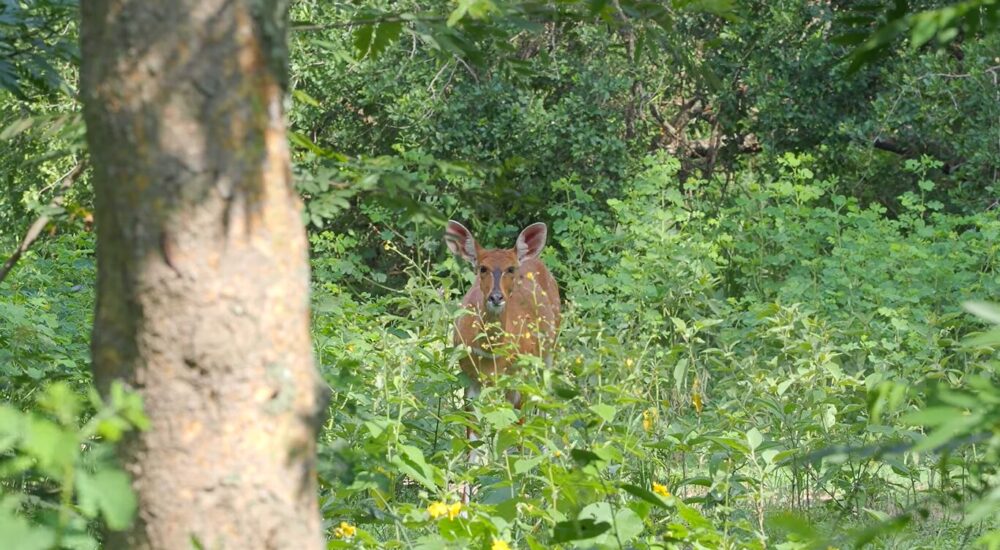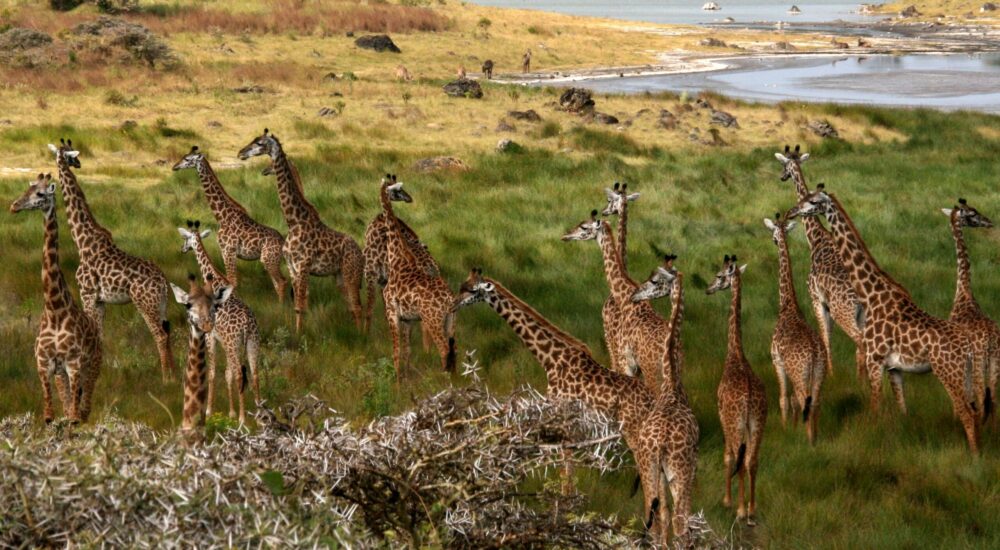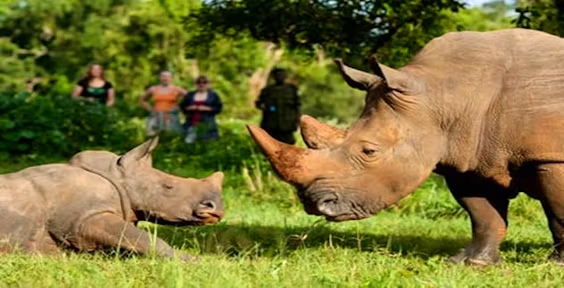Are you dreaming of a wildlife adventure in East Africa? Planning your safari for 2025…
Kenya safaris to Saiwa Swamp National Park
Kenya safaris to Saiwa Swamp National Park – Birding, wildlife and Nature walks.
Visit the Sitatunga antelope sanctuary in Kenya’s Saiwa Swamp National Park on a safari. Saiwa Swamp National Park is a tropical wonderland teeming with rare and unusual flora and fauna, and a true sanctuary for ecotourists. It serves as a sanctuary for the endangered De Brazza’s monkey and is home to the semi-aquatic Sitatunga antelope, both of which are very uncommon.
A wide variety of birds may be found in this tropical wetland habitat, which is a mosaic of riverine forest, sedges, and acacia forests bordered by thick rushes and grass beds. Within the forest, you may see the Narina trogons, collared and orange-tufted sunbirds, the yellow bishop, Hartlaub’s marsh widow bird, and the Noisy Ross’s Turaco, while on the water you can see the lesser jacana, grey heron, and African black duck.
The smallest national park in Kenya, Saiwa Swamp, is home to the semi-aquatic Sitatunga antelope, an incredibly uncommon and endangered species. The park is a verdant, lush swamp with bulrushes, sedges, and riverine woodland. This little park is one of a kind since it is the only area in Kenya where cars are banned and hikers have absolute power. It is seldom frequented, off the beaten path, yet delightfully rewarding.
Located at a height of 1860-1880m in the Cheragani Hills of Trans-Zoiya Province, this modest 3-square-kilometer national park was gazetted in 1974. Restricted to walking trails exclusively, the park lacks roadways. The perimeter fence of the park serves as a clear demarcation between the park and the heavily farmed subsistence smallholdings (called’shambas’) that surround it.
The nearby farmers plow as close to the fence as possible, highlighting the difficult balance that has to be maintained between human well-being and the battle to retain a healthy biodiverse ecosystem. Most cultivation is done on a modest scale using hand tools. In light of this, the Kenya Wildlife Service and the local population must work together closely to ensure the park’s survival.
Saiwa Swamp National Park’s Animals.
Sitatunga, monkeys, spotted-necked otters, leopards, bushbucks, and African civets all call Saiwa home.
Saiwa Swamp National Park Birds.
372 species, including the blue-headed Coucal and the Ross’ Turaco, two very rare birds. Tall bulrushes and sedges, as well as swamps and riverine forests.
Activities in Saiwa Swamp National Park, Kenya, On Safari
What makes this park special is that you can only get here on foot. The area is around 7 km long and has well-kept wooden paths and walkways. There are three wooden lookouts where you may try to see the rare Sitatunga antelope. There are wooden duckboards that run straight over the marsh, and there are also well-marked paths that go around its edge.
The tracking of Sitatunga.
A long-legged antelope that has evolved to feed on the copious food supplies of its wetland environment, the Sitatunga—also known as the ‘Nzohe’ in Swahili—is an exceptional and unusual animal. Its long, spread hooves and oily hair make it invisible on underwater plants, and its shaggy coat keeps it dry. Even though it walks awkwardly on land, the Sitatunga’s highly developed feet allow it to evade its swamp predators.
![]()
Its males have horns and the females sport reddish-brown fur that gives it a very moth-eaten appearance. In order to remain undetected, the Sitatunga moves slowly and deliberately into the water, sinking until it submerges almost its whole body. After that, it stays underwater or finds a shaded spot to spend the most of its day. When threatened, the agile Sitatunga will plunge to great depths, keeping itself submerged up to its snout.
Because of its nocturnal habits and acute shyness, this species only ventures out of the swamp to forage for food in the mornings and evenings. These secretive species have just gotten adapted to human closeness in Saiwa Swamp, while they are found in scattered sites across western and central Africa (especially in the papyrus wetlands of Lake Victoria and the Kingwal Swamp near Kapsabet).
One of the techniques of the profession is to just watch and wait. Also, be on the lookout for the Sitatunga as it navigates the reeds and rushes, particularly between 6 p.m. and 10 a.m., when it’s most active.
Searching for monkeys.
The de Braze monkey’s characteristic white beards and the silky coats of the black-and-white colobus monkey are immediately noticeable. Blue and vervet monkeys are also common. The big forest squirrel and thespotted-necked otter are more challenging. Although leopards are around, you should not expect to see one.
The de Brazza monkey’s characteristic white beard and the silky coat of the black-and-white colobus monkey are immediately noticeable. Blue and vervet monkeys are also common. The big forest squirrel and thespotted-necked otter are more challenging. Although leopards are around, you should not expect to see one.
The Park is home to more than 372 bird species, making birding expeditions a popular attraction for ornithologists. The riverine forests of Kenya are home to some of the country’s rarest species, including the crowned hornbill, the eastern grey plantain eater, and the magnificent Narina trogon.
The grey-crowned cranes are the most noticeable birds in the park, although there are also many ducks, herons, and ibis that eat in the open areas of water. As you make your way around the paths, keep an eye out for cinnamon-chested bee-eaters, paradise flycatchers, and black-headed gonolek. You may also see Ludher’s bush-shrike here; however, it is much harder to notice due to its extreme shyness.
The observation towers are surrounded by warblers and cisticola, while long-crested eagles regularly sit on the bare limbs of dead trees. Hartlaub’s marsh widowbird and yellow bishop call the reeds their home, while blue-headed coucals are common sunbathers among the bulrushes. The fig tree is a powerful attraction for double-toothed barbets while it is fruiting.
Tree recognition system
The park’s very diversified flora includes a fascinating combination of marsh and woodland plants. A variety of grassland, riverine woods, and yellow acacia trees flank it, while towering bulrushes and sedges dominate the area. Orchids and epiphytic ferns are also abundant. Syzygium trees, known for their dark-purple fruits, are prevalent at the edges of swamps, and huge strangler figs are a hallmark of the damper riverine forest.
Identifying insects.
In the swamp, you may see a variety of beautiful dragonflies and damselflies, and as you go down the paths, you’ll see a plethora of jewel-colored butterflies, including swallowtails, charaxes, and the African mocker swallowtail, among many more.
Reptiles and amphibian identification.
The marsh is a favorite habitat for Bell’s hinged tortoise and is home to many amphibians, including tree frogs, who make a lot of noise when it rains. The African rock python and the forest cobra are both snakes. A side-striped chameleon may be hiding along the paths, so keep an eye out for it.
What is the best way to reach Saiwa Swamp National Park?
About 400 kilometers northwest of Nairobi is Saiwa National Park.The use of a 4×4 vehicle makes it easy to navigate the road. Vacation rentals in Saiwa National Park. Vacation rentals in Saiwa National Park. Guests at Saiwa Swamp National Park may choose from a variety of nearby hotels and resorts, including the Aturukan, At’ease, Crane, and Horizons.
When to go to Saiwa National Park for the best experience.
The typical climate of African wetland ecosystems, with two distinct wet seasons (March–June and October–November) and a wide range of temperatures and humidity levels.to any time of year, visitors are welcome to the national park. Savanna Swamp National Park safaris in Kenya may be arranged via Monumental Expeditions and Safaris.


